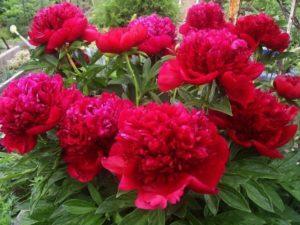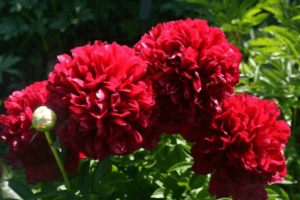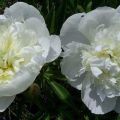Description and characteristics of the Solange peony variety, the subtleties of growing and reproduction
Perennial flowers are actively used by all summer residents for site design. Peonies are among the ten most popular plants. They have many benefits, which include abundant flowering, beauty in appearance, and sophisticated plant scent. Not everyone knows about the herbaceous peony Solange, but its excellent characteristics speak in favor of choosing this variety.
Description and features
The main advantages of the Solange variety will be that:
- the height of the bush is about a meter;
- forms a spreading bush, strong stems;
- leaves are green fleshy, cut, up to 30 centimeters long;
- the diameter of a double flower is 19 centimeters.
The color of the peony is delicate with shades of pink and cream. It is the flowers that give the whole plant a decorative look. Sometimes the stems bend under the weight of the globular buds. A multitude of terry petals, creamy, pink or shimmering with snow-white purity, attract attention with their unique aroma.
The variety belongs to the late types of ornamental culture, so the petals do not fall off for a long time, they last until mid-summer.
The powerful root system of the peony allows the perennial to grow in one place for a long time. The culture can withstand severe frosts, it is not afraid of heavy rains.
Landing
For a flowering perennial, it is important to choose the right place to grow. Having taken root, the Solange peony will delight with flowering for 15-20 years.
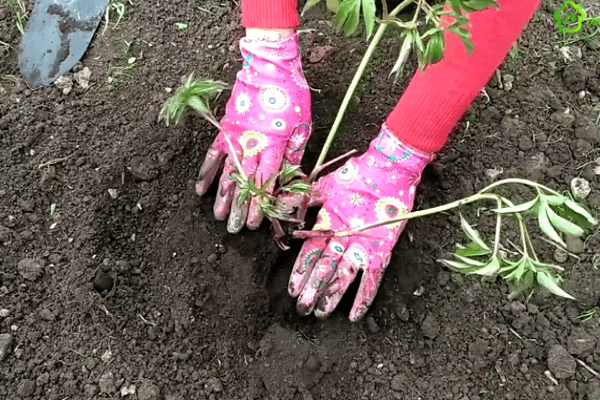
Timing
It is best to plant the flower in spring or fall. Spring planting should take place in April, when the soil warms up to 10 degrees Celsius.
In the middle lane, it is preferable to plant a peony in late summer - early autumn. During this period, the culture is dormant, and therefore the seedlings will easily take root.
Seat selection
Peony Solange needs a place where:
- sunny;
- no stagnant water;
- soil with neutral acidity.
You can plant plants where there is little shade. But in constant shade, the bushes will not bloom for long.
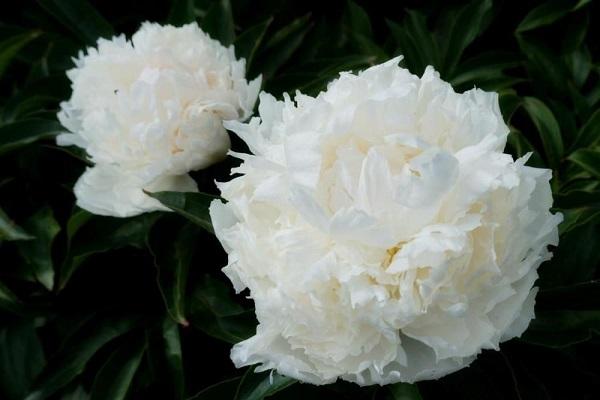
Soil requirements
For a varietal herbaceous peony, loamy soil is suitable. It must contain humus. Before planting, they are mixed with the ground, except for 100 grams of humus, 300 grams of wood ash, 200 - superphosphate. For acidic soils, slaked lime is added.
Landing scheme
For a seedling, a pit is prepared in advance. The depth of the hole should be between 50 and 60 centimeters. Its width corresponds to 35-45 centimeters. It is necessary to put drainage on the bottom so that the water does not stagnate and the roots do not rot. Broken brick, expanded clay, crushed stone are suitable for the drainage layer.Then a layer of river sand is needed, and then the pit is filled with nutritious soil.
Moisten the soil before planting. The lower peony buds should not be deepened, leaving them 4-5 centimeters above ground level. But the rhizome should be at a depth of 5-10 centimeters to the soil surface.
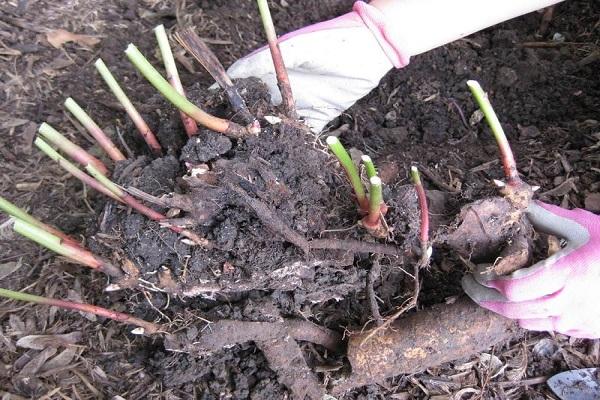
Care
It is necessary to take care of peonies correctly. The flowering and life expectancy of ornamental bushes depends on competent agricultural technology.
Watering
For better growth and development, Solange peony requires regular watering. It is enough to moisten the bushes 2 times a week, in dry periods - 3-4. An adult plant will need 15-20 liters of water. Take water at room temperature, well-separated.
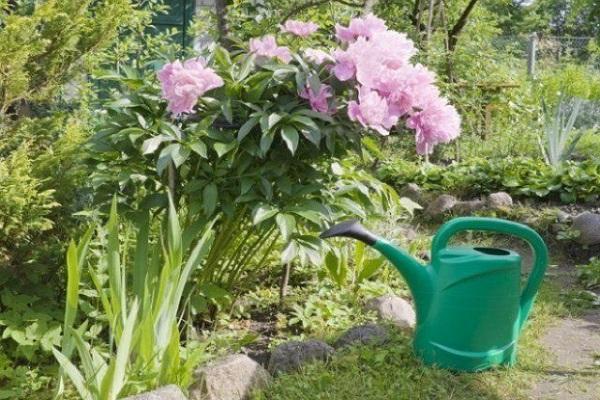
Growth stimulants
It will be better to grow decorative herbaceous perennials if the roots of the seedlings are treated with growth stimulants before planting. Young peonies will bloom only 2-3 years after planting. Flowering can be accelerated by alternating mineral and organic dressings. In the spring, the sprouts are sprayed with a urea solution, taking 50 grams per 10 liters of water. Then they are treated with mineral complexes a month later and after flowering.
Top dressing
It is necessary to start feeding adult plants from the 3rd year of life. In the spring, nitrogenous compounds are needed to build up green mass. Urea will do, a tablespoon in a bucket of water. During the appearance of buds, fertilizers containing phosphorus and potassium are used. You can take 50-60 grams of nitrophoska per 10 liters of water.
When Solange peonies have bloomed, they are watered with a nutrient solution of superphosphate and potassium salt.
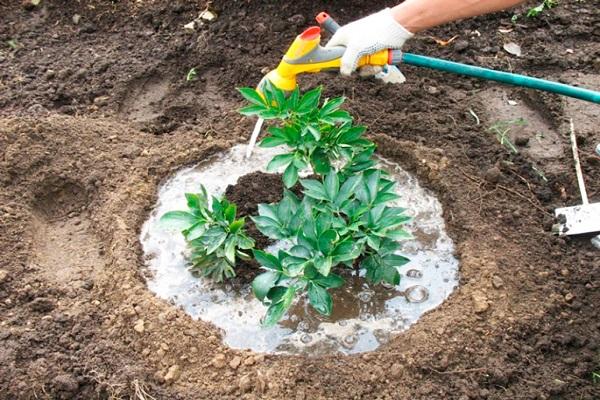
Loosening and weeding
To improve the permeability of the soil around the peonies, the soil is loosened. The procedure is required up to 3-4 times per season. Weeds are removed at the same time. They are carriers of diseases and pests.
Pruning
Peony stems are cut in the fall after flowering stops and the plant is dormant. Leave hemp 3-4 centimeters high.
During the growing season, remove damaged, dry stems and leaves. As the flowers dry, they are also removed.
Prevention of diseases and pests
Improper care provokes the development of diseases in a peony. Every gardener can prevent them. It is necessary to weed out weeds in time, to avoid stagnation of moisture near the bushes of the plant.
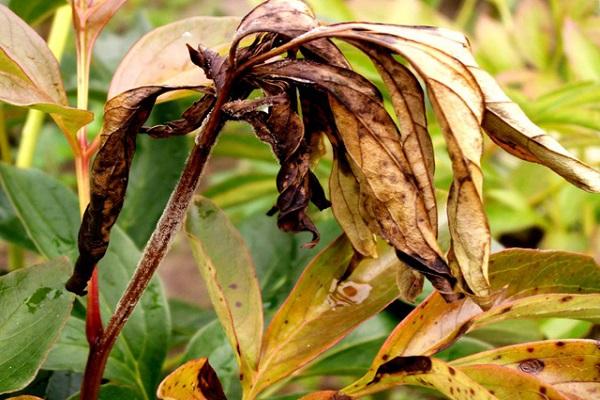
Gray rot
The sudden wilting of the bushes causes the fungus of Botrytis. In this case, the stems rot, and the buds become hard and black. The first step is to cut off all the affected parts of the plant, and treat the bushes with fungicidal preparations such as Ridomil Gold.
Reducing soil acidity will be a preventive method against disease. It is best to liming the soil with dolomite flour. In April, it is necessary to treat the plants with Bordeaux liquid, carrying out the following procedure after 2 weeks.
Root rot
In wet summer, flooding of the area under the flowers, blackening and wilting of perennial stems occur. The bushes affected by the fungus are dug up, revealing slimy roots that emit an unpleasant odor. To avoid illness, phosphorus-potassium fertilizers should be applied on time.
Rust
The disease begins with the appearance of brown spots on the upper plate of the leaves. Then the foliage dries up and falls off. The spread of fungi can be prevented by timely cleaning and burning of plant residues.
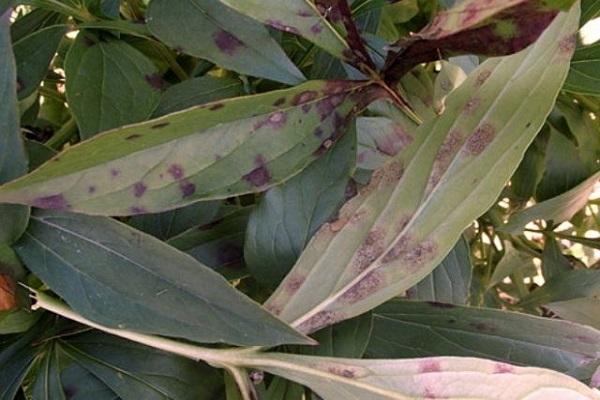
Mosaic
A viral infection manifests itself during the regrowth of the lateral shoots of the peony. Semirings and stripes of a dark tone on the leaves alternate with light ones. Parts of the bush damaged by the disease should be cut out, and the wounds should be sprinkled with crushed activated carbon.
Reproduction
The peony is characterized by both seed propagation and vegetative propagation.It is better to use the methods of dividing a bush or rhizome, since the varietal characteristics of the Solange peony are preserved.
Dividing the bush
In early spring, they shake off the ground from the peony bush. With a sharp shovel, part of the bush is separated along with the rhizome. The rest is sprinkled with earth and sawdust. You can plant plots in the fall.
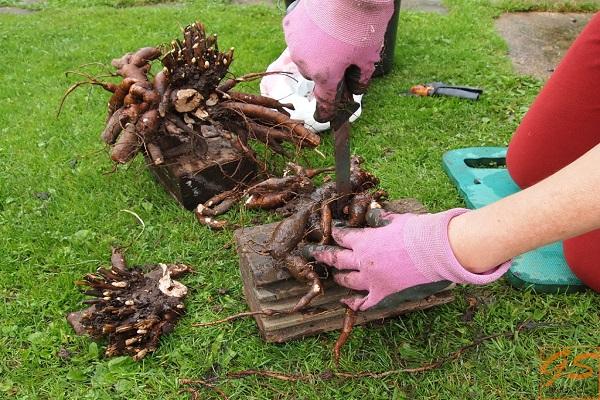
Rhizome division
This method requires digging up 3-4 year old peonies. Before the procedure, the stems should be cut off. The dug root is washed, slightly dried. Then the rhizome is cut into several parts with a sharp tool. Each should have 2 adventitious roots 10 centimeters long and 2-3 developed eyes. It is necessary to withstand the material in the air before planting so that the cut points dry out.
The best breeding period is considered August-September.
